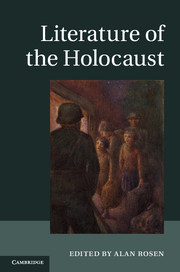Book contents
- Frontmatter
- Contents
- Notes on contributors
- Acknowledgments
- Introduction
- Part I Wartime victim writing
- Part II Postwar responses
- Chapter 3 The Holocaust and Italian literature
- Chapter 4 German literature and the Holocaust
- Chapter 5 Hebrew literature of the Holocaust
- Chapter 6 The Holocaust and postwar Yiddish literature
- Chapter 7 The Holocaust in Russian literature
- Chapter 8 The Holocaust in English-language literatures
- Chapter 9 Polish literature on the Holocaust
- Chapter 10 Hungarian Holocaust literature
- Chapter 11 French literature and the Holocaust
- Part III Other approaches
- Guide to further reading
- Index
- References
Chapter 5 - Hebrew literature of the Holocaust
Published online by Cambridge University Press: 05 June 2014
- Frontmatter
- Contents
- Notes on contributors
- Acknowledgments
- Introduction
- Part I Wartime victim writing
- Part II Postwar responses
- Chapter 3 The Holocaust and Italian literature
- Chapter 4 German literature and the Holocaust
- Chapter 5 Hebrew literature of the Holocaust
- Chapter 6 The Holocaust and postwar Yiddish literature
- Chapter 7 The Holocaust in Russian literature
- Chapter 8 The Holocaust in English-language literatures
- Chapter 9 Polish literature on the Holocaust
- Chapter 10 Hungarian Holocaust literature
- Chapter 11 French literature and the Holocaust
- Part III Other approaches
- Guide to further reading
- Index
- References
Summary
Introduction
Hebrew literary responses to the Holocaust are frequently characterized by a complex engagement with the Hebrew language itself. The liturgical and scholarly language of the Jews, Hebrew was transformed in the modern era into the lingua franca of the State of Israel. In light of the fact that the literature under investigation documents responses to the destruction of a population that often lived between Hebrew and Yiddish, with Hebrew being the language of prayer and sacred study and Yiddish being the vernacular tongue, the separation of Hebrew responses to the Holocaust from Yiddish ones is a product of the reinvention of Hebrew, since the inception of Modern Zionism, as a Jewish secular language existing independent of its Yiddish peer. This chapter will focus on literary responses to the Holocaust in Israeli Hebrew-language literature. I will also have an eye toward assessing the cost of excising Yiddish, both as a language and as a symbol of Jewish life in the Diaspora. Hebrew Holocaust literature has been produced in non-Israeli contexts as well, most notably in the American Hebrew poetry of Avigdor ha-Meiri, Reuven Wallenrod, Israel Efros, and Gabriel Preil, among others. This chapter, however, will trace Hebrew responses to the Holocaust, primarily in Palestine and Israel, from 1945 to the present.
Our survey begins with discussion of a “bridge generation” – mostly multilingual, Eastern European-born writers who immigrated to Palestine before the war and chose not to write explicitly about the Holocaust in its aftermath, but alluded to it obliquely and subtly in their Hebrew works. This is followed by an exploration of “the seventh million” or trends in Israeli literary responses to the Holocaust, beginning with an interrogation of the theme of collaboration and resistance in Israeli drama and continuing with the poetry and fiction of Holocaust survivors who made their careers in Israel and their literary reputations in Hebrew. We conclude with a discussion of the work of the second and third generations – the population that inherited the trauma of their forebears, both individually and collectively, and who wrote in Hebrew after the war because that was their native tongue and they no longer lived in a multilingual, or diglossic Jewish diaspora environment.
- Type
- Chapter
- Information
- Literature of the Holocaust , pp. 84 - 101Publisher: Cambridge University PressPrint publication year: 2013
References
- 2
- Cited by



